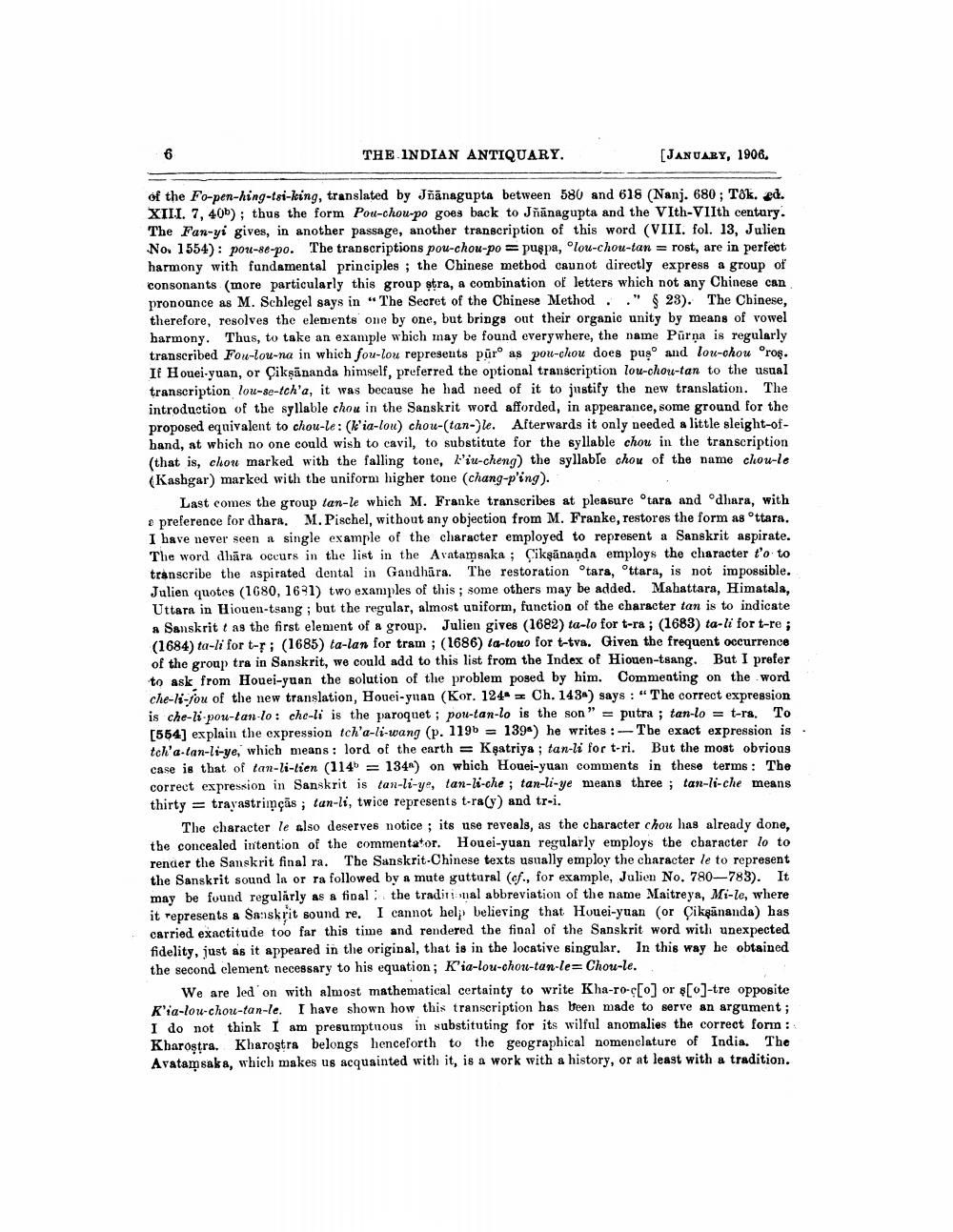________________
THE INDIAN ANTIQUARY.
[JANUARY, 1906
of the Fo-pen-hing-tsi-king, translated by Jñanagupta between 580 and 618 (Nanj. 680 ; T8k. ed. XIII. 7, 40b); thus the form Pou-chou-po goes back to Jñanagupta and the VIth-VIIth centary. The Fan-yi gives, in another passage, another transcription of this word (VIII. fol. 13, Julien No. 1554): pou-86-po. The transcriptions pou-chou-po = puppa, lou-chou-tan = rost, are in perfect harmony with fundamental principles ; the Chinese method caunot directly express a group of consonants (more particularly this group stra, a combination of letters which not any Chinese can pronounce as M. Schlegel says in "The Secret of the Chinese Method . ." 23). The Chinese, therefore, resolves the elements one by one, but brings out their organic unity by means of vowel harmony. Thus, to take an example which may be found everywhere, the name Pūrņa is regularly transcribed Fou-lou-na in which fou-lou represents pūro as pou-chou does pus and lou-chou roş. If Houei-yuan, or Çikşananda himself, preferred the optional transcription lou-chou-tan to the usual transcription lou-se-tch'a, it was because he had need of it to justify the new translation. The introduction of the syllable chou in the Sanskrit word afforded, in appearance, some ground for the proposed equivalent to chou-le: (k'ia-lou) chou-tan-)le. Afterwards it only needed a little sleight-ofhand, at which no one could wish to cavil, to substitute for the syllable chou in the transcription (that is, chou marked with the falling tone, k'iu-cheng) the syllable chou of the name chou-le (Kashgar) marked with the uniform higher tone (chang-p'ing).
Last comes the group tan-le which M. Franke transcribes at pleasure otara and "dhara, with e preference for dhara. M. Pischel, without any objection from M. Franke, restores the form as ottara. I have never seen a single example of the character employed to represent a Sanskrit aspirate. The word dhāra occurs in the list in the Avatamsaka ; Çikşānanda employs the character to to transcribe the aspirated dental in Gandhāra. The restoration 'tara, ottara, is not impossible. Julien quotes (1680, 1691) two examples of this; some others may be added. Mahattara, Himatala, Uttara in Hiouen-tsang; but the regular, almost uniform, function of the character tan is to indicate a Sanskrit t as the first element of a group. Julien gives (1682) ta-lo for t-ra ; (1683) ta-li for t-re; (1684) ta-li for t-r; (1685) ta-lan for tram ; (1686) la-touo for t-tva. Given the frequent occurrence of the group tra in Sanskrit, we could add to this list from the Index of Hiouen-tsang. But I prefer to ask from Houei-yuan the solution of the problem posed by him. Commenting on the word che-li-fou of the new translation, Houei-yuan (Kor. 124* - Ch. 143a) says : "The correct expression is che-li-pou-tan-lo: che-li is the paroquet ; pou-tan-lo is the son " = putra ; tan-lo = t-ra. To (554] explain the expression tch'a-li-wang (p. 1196 = 1398) he writes :- The exact expression is tch'a-tan-li-ye, which means : lord of the earth = Ksatriya ; tan-li for t-ri. But the most obvious case is that of tan-li-lien (1146 = 134") on which Houei-yuan comments in these terms: The correct expression in Sanskrit is tan-li-ye, tan-li-che; tan-li-ye means three ; tan-li-che means thirty = trayastriipçãs ; tan-li, twice represents t-ra(y) and tr-i.
The character le also deserves notice ; its use reveals, as the character chou has already done, the concealed intention of the commentator. Houei-yuan regularly employs the character lo to render the Sanskrit final ra. The Sanskrit-Chinese texts usually employ the character le to represent the Sanskrit sound la or ra followed by a mute guttural (cf., for example, Julien No. 780—783). It may be found regularly as a final: the traditi-nal abbreviation of the name Maitreya, Mi-le, where it represents a Sanskrit sound re. I cannot help believing that Houei-yuan (or Çikaānanda) has carried exactitude too far this time and rendered the final of the Sanskrit word with unexpected fidelity, just as it appeared in the original, that is in the locative singular. In this way he obtained the second clement necessary to his equation; K'ia-lou-chou-tan-le=Chou-le.
We are led on with almost mathematical certainty to write Kha-ro-c[0] or []-tre opposite K'ia-lou-chou-tan-le. I have shown how this transcription has been made to serve an argument; I do not think I am presumptuous in substituting for its wilful anomalies the correct forn: Kharoştra. Kharoştra belongs henceforth to the geographical nomenclature of India. The Avatamsaka, which makes us acquainted with it, is a work with a history, or at least with a tradition.




